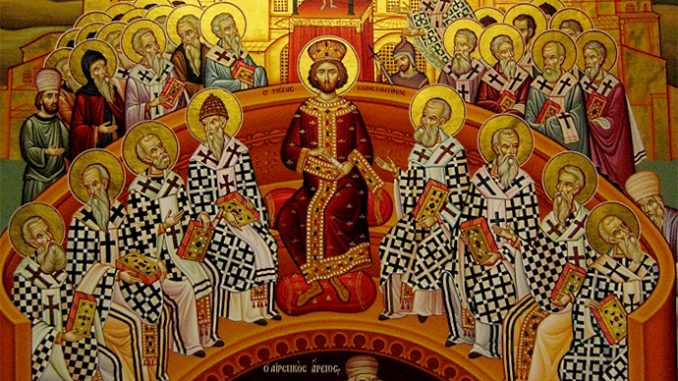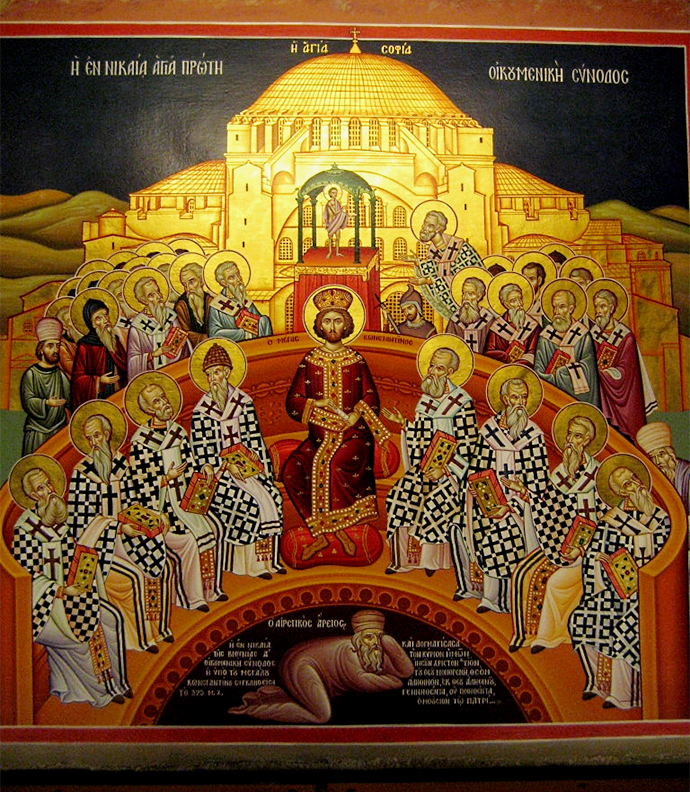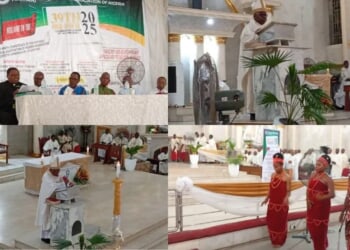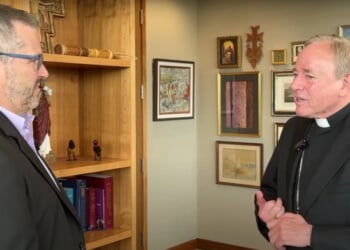
May 20 marked the 1700th anniversary of the beginning of the Council of Nicea in 325 A.D. June 19 marks the date of the drawing up of the “Symbol” or “Nicene Creed,” the first draft of what would later become a part of the Eucharistic liturgy for the universal Church. August 19 is generally accepted as the close of the council.
The celebration of the First Ecumenical Council is an occasion not merely to look back on a seminal event of the Church’s past, but to meditate on how Christ has continued to work and will work in His Church till the end of time.
Looking back at the history itself is useful. It can be tempting to look back through rose-colored glasses on the “early, undivided Church” and imagine that things were perfect. Yet the reality is quite different. The Church of the first three centuries was a body often persecuted by the Roman government. This persecution was sporadic, and scholars debate the details and severity of the various instances. But Christians had to be vigilant. The new and underground Church was illegal, and Roman law was a consistent threat.
The Emperors Constantine and Licinius (Rome did not have a single emperor at the time) granted official toleration to open Christian practice in the 313 A.D. Edict of Milan. The new freedom given to the Church was wonderful. Rome’s removal of an external threat allowed the Church to breathe. Yet now an internal threat arose: the new teaching of the priest Arius of Alexandria.
Arius’s teaching was not to break the peace of the Church and violate the rule of faith that had been handed down by the Apostles. A Roman presbyter in the early 100s named Marcion had attempted to teach that the God of the Old Testament was definitely not the God of the New Testament. The former was like the Platonic demiurge (“craftsman” in Greek); the latter was the real God, who was all-powerful. Like Thomas Jefferson centuries later, Marcion edited biblical books. Some think he was the first compiler of a New Testament canon: he chose ten letters of St. Paul and only St. Luke’s Gospel, which he edited to expunge anything that made Jesus look like he had a connection with the Jewish God. In Marcion’s wake were various other Gnostic groups, all trying to make sure nobody thought Jesus was truly human. In the first few centuries of the Church, it might be said that it was harder to believe Jesus was human than that he was divine, albeit some sort of emanation from a supreme being.
So, even amid the external threats to the Church, there were always internal threats to the Church’s life and belief about what was most important: the question of who Jesus is. But Arius’s thought had a different kind of appeal. Not tangled up in strange mythologies as some of the oddball Gnostic sects were, the Egyptian priest’s theories were proposed as biblical and logical. God is one and His essence cannot be shared. The Son, he said, was the highest being in all of God’s creation. As such, he would certainly reflect God’s goodness, but he was ultimately a creature—the highest angel, if you will, created in time and not begotten.
Arius’s teachings had riled up the entire Church in Egypt and had spread well beyond by the early 320s. Around 320, Alexander, Bishop of Alexandria, had called a local council of Egyptians and Libyans to deal with Arius’s teachings. They condemned them, but Arius continued to serve as a priest. When he was finally run out of his own church, he went on to Palestine and Nicomedia (in present-day Turkey). The Emperor Constantine, who had by 322 conquered Emperor Licinius to gain sole control over the entire Roman Empire, decided that these religious disputes within the Christian Church required a settlement. Like any good politician, he encouraged everyone to shake hands and come to agreement—not realizing how serious the questions were. When this didn’t work, he decided to call for a universal or ecumenical council to settle the matter.
Did he consult with the Bishop of Rome, Pope (Saint) Sylvester? Quite possibly. In any case, the pope agreed to the meeting and sent two legates to this council held in Nicea (also rendered Nicaea), the modern-day city of Iznik, Turkey. There were, St. Athanasius tells us, 318 bishops present. The number was seen as significant because it is the same number of servants that Abraham took to rescue his nephew Lot in Genesis 14. Many other priests and deacons also attended. Most important was that young Egyptian deacon already named—Athanasius—who would go on to speak powerfully at the council and become one of the great theologians of the Church.
Interestingly, there were even Christian bishops from outside the Roman Empire. By the fourth century, Christianity was more universal than Rome! The emperor presided over the proceedings, though when they got to the theological debates, his participation was limited. The accounts we have tell us that Arius was able to present his case to the assembled. The story that St. Nicholas punched him is probably apocryphal, but the story represents the strong reaction of those assembled to this theory. They may have been impressed with Arius’s biblical acumen, but they judged his theory on the basis of the Tradition of the Church passed down to understand the scriptures. The Tradition held that the Son was no mere creature, did not merely share a unity of will with the Father, and did not begin in time.
The fathers of the Council of Nicea drew up a creed in order to restate the orthodox view. That creed included a new term that was not biblical: homoousios. It meant one in being or substance, consubstantial. The Son’s unity with the Father involved his very essence. Though some of the “semi-Arians” had presented a compromise term, homoiousios, of like or similar substance, it was rejected in favor of the one we know because only homoousios was the truth about the Son who was begotten and not made, very God of very God. In the end, all but two bishops voted for this understanding: Jesus is one in being with the Father.
After that creed had been drawn up, the assembled bishops turned to more practical matters. They passed twenty canons dealing with disciplinary matters. We know that many of these disciplinary canons were not necessarily accepted. The second canon prohibits new converts from taking ecclesial office. We know, however, that later in the century, the catechumen Ambrose would be initiated into the Church and ordained only after being chosen as the new bishop of Milan. The fifteenth canon condemns bishops, priests, or deacons from moving from city to city. The desire to climb the greasy ecclesiastical pole to richer and more important places has always been with us.
One important lesson from the Council of Nicea is that many of our problems have always been with us. And because times change, we must remember that the Church’s disciplines may have to change to accommodate new situations. Disciplinary canons are not infallible.
Even on the topic of doctrine, however, we have to remember that the orthodox teaching of this council was not accepted right away. Indeed, Arianism seemed to go from strength to strength over the next few decades. St. Athanasius’s life was a series of adventures defending the orthodox teaching while being chased down by Arian supporters. We really need a great film or series about the adventures of Athanasius, defender of the faith against Arians, who did not stop just because the Council told them to. Decades after the council, St. Jerome wrote, “The whole world groaned, and was astonished to find itself Arian.”
Indeed, the lesson of the Council of Nicea is that the Church has the ability to decide the truth of matters, but there is no guarantee that this truth will be accepted by all her members, perhaps especially not her clergy. It was not until at least the Second Ecumenical Council of Constantinople in 381 that the Church had (kind of) put the Arian Crisis behind her. It was at this council that the fathers took out that old creed from Nicea, edited it, and filled in some of the gaps, this time specifying not only the divinity of the Son but also the Holy Spirit in language that could not be mistaken.
When we are tempted to long for those halcyon days of yore, let us remember that God does his greatest work even amid the very mixed use of free will by men and women who are still themselves in the process of gaining holiness. The Council of Nicea is a testimony to the ways in which the Lord will lead us to truth, but will not save us from the need to contend for it. Nor will He solve all our practical problems right away. That’s all right, for this is the way in which He forges saints out of young Egyptian deacons…and you and me.

If you value the news and views Catholic World Report provides, please consider donating to support our efforts. Your contribution will help us continue to make CWR available to all readers worldwide for free, without a subscription. Thank you for your generosity!
Click here for more information on donating to CWR. Click here to sign up for our newsletter.








